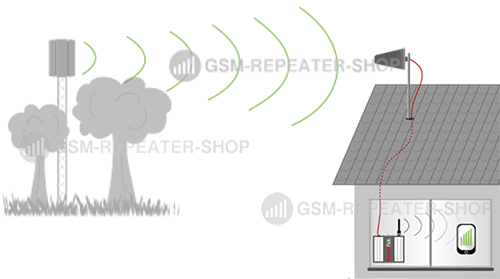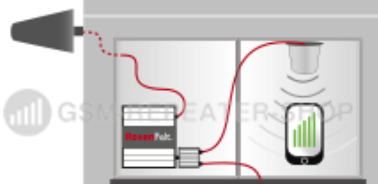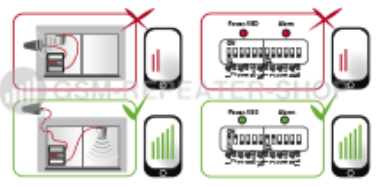
How to install a mobile signal repeater and increase the telephone coverage on your phone!
A mobile signal repeater receives the signal from a transmission tower through an external antenna, which is connected to the repeater with a coaxial cable. Depending on your needs, you can connect one or more indoor antennas to the GSM repeater.
The repeater will need power and will need to be connected to the electricity, and that's it!
What should I take into account when selecting repeaters and accessories?
Several factors are determining in the choice of your repeater to successfully increase mobile phone coverage. If you have any further questions, do not hesitate to contact us, we will be happy to assist you.
Particularly for large projects, we advise you to visit us so that we can analyze your plans and advise you on a totally customized system.
What points should I pay attention to to successfully increase the coverage of my telephone network:
- My operator / The quality of my telephone network (number of bars)
- My need, the signal I want to increase: GSM and 3G and / or 4G and 4G LTE or all of them?
- How far away is the transmission tower and what signal does it produce? If you do not know where the transmitting antenna is located, you can trust the reception (number of bars) of your telephone network that you have outside; or ask us where is your nearest BTS.
- What is the topography, landscape (mountains, forest, etc.)?
- What is the interior layout of the place to be improved and its size?
You can also enter this data in our inquiry form and we will offer you a solution or we will contact you directly.
To install your GSM repeater
A tip to facilitate the installation of the GSM repeater: do it between 2 people!
1) Think carefully where you want to place the outdoor antenna:
It must be installed in a place where it has good mobile reception and where the length of the coaxial cable to connect it can reach, which should not exceed 10M (20M in some cases). For example on the roof or on the facade. If the outdoor antenna is installed correctly, this will ensure success in improving telephone reception. Here's the rule of thumb: the weaker the mobile phone signal outdoors, the higher the antenna should be, and you should consider a stronger antenna if the signal is very weak.
Tip: Do a test installation first, for example through a skylight or similar, before proceeding with the final installation.
2) Connect the outdoor antenna to the GSM repeater using the supplied cable:
The coaxial cable must go from the outside to the inside and be connected to the repeater there.
Make sure that there is enough ground and distance between the outside antenna and the GSM repeater, in order to avoid interference and to ensure the coverage of the phone.
You can find more information about this in your user manual. If you have any questions during installation, you can call our customer service!
3) Install your indoor antenna with an extension kit :
To bring the signal received by the outdoor antenna indoors, you will need to connect the indoor antenna to the repeater. If you have a larger installation, connect splitters, couplers , coaxial cables , roof antennas or wall antennas to distribute the signal evenly inside.
Tip: Make sure the indoor antenna is connected to the INDOOR output and the outdoor antenna to the OUTDOOR output.
4) Connect your GSM repeater to the network:
If you have correctly installed the repeater: the indoor antenna at the INDOOR outlet and the outdoor antenna at the OUTDOOR outlet, you can now connect the GSM repeater to power supply.
Next, check your extender's LEDs for any interference and make a call or request to be contacted to see if your mobile phone reception has actually increased.
Tip: All LEDs on your repeater must be green for your mobile phone to receive optimal reception.
5) Troubleshooting: LEDs, DIP switches and feedback.
You have the option of setting your repeater to turn off any feedback. Our repeaters have a feature called AUTO SHUT OFF, which means that in the event of feedback, the device shuts down.
Now the following factors come into play:
- Are the indoor and outdoor antennas far enough apart and is there enough mass between them?
- How are the DIP switches located on the back of the repeater?
- What color are the LEDs
In principle, these rules apply to configure your GSM repeater optimally:
- With the DIP switches you can dim the repeater if not all LEDs are green.
- There are DIP switches for each frequency, which are then divided into UL (uplink) and DL (downlink), connecting them in parallel.
- DIP switch down means no attenuation, DIP switch up means attenuation
- The higher the attenuation, the lower the repeater power
For any other question, you can consult the FAQ or contact us




